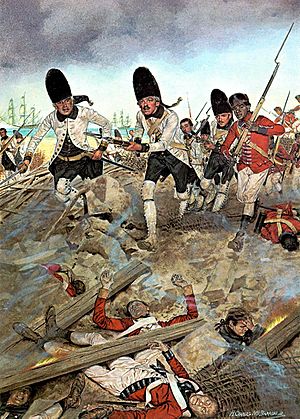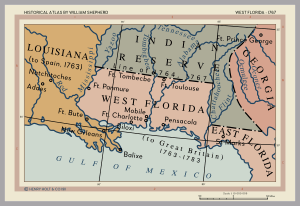John Campbell, of Strachur facts for kids
Quick facts for kids
John Campbell, of Strachur 17th Clan Chief of the MacArthur Campbells of Strachur
|
|
|---|---|
| Born | 1727 Argyll, Scotland |
| Died | 28 August 1806 (aged 78 or 79) Argyll, Scotland |
| Allegiance | |
| Service/ |
|
| Rank | General |
| Commands held | Commander-in-Chief, North America |
| Battles/wars | Jacobite rising of 1745 War of the Austrian Succession Seven Years' War American War of Independence |
John Campbell (1727 – 28 August 1806) was a Scottish soldier and nobleman. He became a General in the British Army. He is best known for leading British forces during the Siege of Pensacola in America. After the American Revolutionary War, he became the top British commander in North America in 1783.
Contents
Early Military Career
John Campbell became the 17th Chief of the Strachur branch of Clan Campbell after his father died. In June 1745, he joined the army as a lieutenant in a Highland regiment.
Fighting in Scotland and Europe
Young Campbell quickly showed he was a skilled soldier. He fought for the British Army during the Jacobite rising of 1745 in Scotland. He was even wounded in the famous Battle of Culloden. After that, he served in Flanders in 1747 during the War of the Austrian Succession. He became a captain that same year. When the war ended in 1748, he took a break from active duty.
Seven Years' War (1756-1763)
In 1756, Campbell was called back to serve in the army. He joined the 42nd (Royal Highland) Regiment of Foot, also known as the Black Watch Regiment. He served under a famous general named James Wolfe.
Battles in North America and the Caribbean
Campbell was wounded again during the Battle of Carillon in the French and Indian War (which was part of the Seven Years' War). After he recovered, he was promoted to major. In February 1762, he became a lieutenant colonel. He led the 17th Foot regiment in attacks against Martinique and Havana in the Caribbean.
Later, in 1773, he became the commanding officer of the 57th Regiment of Foot. This regiment was mostly made up of Irish soldiers and was stationed in Ireland. In December 1775, his regiment sailed from Ireland to fight in the American Revolutionary War.
American War of Independence
Leading the 57th Regiment
Campbell's regiment arrived off the coast of North Carolina in April 1776. They then moved to attack Charleston, South Carolina. The 57th Regiment was ordered to cross to Sullivan's Island, but the water was too deep. They avoided direct fighting there.
Later, in August 1776, Campbell and his regiment landed on Long Island, New York. They were part of a brigade that made a distracting attack during the Battle of Long Island. This helped the main British attack succeed.
Taking Forts in New Jersey and New York
On September 23, 1776, Campbell led his regiment to capture the fortifications at Paulus Hook, New Jersey. The American soldiers had already left, so Campbell took the fort without any fighting. This fort became an important British base in New Jersey.
On October 6, 1777, Campbell led the 57th Regiment in storming Fort Montgomery in New York. His unit had some soldiers injured, but he was unharmed. After destroying the fort, the British returned to New York.
In October 1778, Campbell's regiment was sent to raid Egg Harbor, New Jersey. The British had trouble landing their troops. Campbell ordered a successful surprise attack at night. However, the British had to leave before finishing all their goals. Soon after, Campbell was promoted to Brigadier General.
Commanding West Florida
In October 1778, Brigadier General John Campbell was sent to Pensacola in West Florida. He was ordered to take command of all British troops there.
When Campbell arrived, he found the conditions in Pensacola very difficult. He reported to London that he had no money, no ships, no tools, and not enough supplies. He immediately started working to improve things. By September 1779, he began building a new fort on the Mississippi River.
Campbell brought more troops to Pensacola, including soldiers from Germany and American loyalists. He also had the 16th and 60th Regiments. The governor of West Florida had also formed a local cavalry unit. These new troops helped strengthen the defenses. However, more soldiers also meant problems with housing and food.
On February 19, 1779, Campbell was promoted to Major General. On March 22, 1779, he was given full control over all troops in West Florida.
Preparing Defenses
Campbell realized that the harbors of Pensacola and Mobile needed stronger defenses. Pensacola's fort was old and too close to the water. Mobile's harbor was protected by an old brick fort. Campbell knew these forts were not strong enough.
Britain sent supplies and provisions to Pensacola. An officer named Alexander Cameron was put in charge of Native American affairs and was to follow Campbell's orders. By April 1779, Campbell reported good progress on his defense plans.
Spanish Attacks Begin
On June 21, 1779, Spain declared war on Britain. Campbell received a secret order to attack New Orleans if he thought it was possible. He started preparing by gathering ships, troops, and Native American allies.
However, the Spanish governor of Louisiana, Bernardo de Gálvez, also learned of the British plans. On September 11, 1779, Gálvez led Spanish forces against British forts on the lower Mississippi River. He captured Fort Bute and Fort New Richmond at Baton Rouge. Because the Spanish stopped British messages, Gálvez captured most of western West Florida before Campbell even knew about it.
On September 14, 1779, Campbell was ready to attack New Orleans. But then he heard about Gálvez's success on the Mississippi. With the loss of the Mississippi area, Campbell focused on defending the eastern part of West Florida. He tried to get the Chickasaw, Cherokee, and Creek Native American tribes to help the British.
Loss of Mobile
On the same day Campbell told General Sir Henry Clinton about the situation, the Spanish were attacking Fort Charlotte and Mobile. On March 14, 1780, Fort Charlotte and Mobile surrendered to the Spanish. Campbell had left Pensacola with more troops on March 5, 1780, but bad weather slowed him down. When his scouts reported that the Spanish flag was flying over the fort, Campbell turned back to Pensacola.
With Mobile lost, West Florida was reduced to just the Pensacola area. Campbell felt that if even one British warship had been there, Mobile could have been saved.
Unsuccessful Counterattack
While Governor Gálvez prepared to attack Pensacola, Campbell and Governor Chester argued again. The governor tried to limit Campbell's power over the troops. Campbell expected a Spanish attack in late 1780, but it didn't happen.
Tired of waiting, Campbell sent Colonel Johann von Hanxleden with over 500 men in January 1781. Their mission was to capture the Spanish fort on the east side of Mobile Bay, which supplied water to Mobile. The attack failed because Hanxleden was killed, and no one took charge. Also, the British Native American allies refused to follow the soldiers into the fort.
Siege of Pensacola
The long-awaited Spanish attack on Pensacola began in early March 1781. On March 11, Gálvez's ships entered Pensacola Bay after taking Santa Rosa Island. On March 21, 1781, Campbell suggested to Gálvez that the town and soldiers of Pensacola should be spared. However, that night, a British officer burned some houses. This made Gálvez accuse Campbell of not being honest.

More Spanish and French troops arrived from Mobile, New Orleans, and Cuba. Campbell encouraged his troops to defend Fort George. But without naval support or enough cannons, the Spanish artillery broke through the fort's walls on May 8, 1781. A powerful Spanish fleet also attacked the town.
On May 10, 1781, John Campbell surrendered Fort George to the Spanish. Governor Gálvez offered generous terms, allowing the British troops, including Campbell, to return to New York.
Campbell was first taken to Havana, Cuba, where he was paraded through the city. The Spanish governor who did this was later imprisoned for it. Campbell was then sent back to British territory. He stayed in New York City until the British left on November 25, 1783, after the Treaty of Paris ended the war.
Later Life
In 1783, Campbell took over from Sir Guy Carleton as the top British commander in North America. He held this position until 1787. He then returned to Scotland and built Strachur House.
Later in life, Campbell often spoke about his difficult time in West Florida. He said he had worked tirelessly to keep West Florida for the British Empire. He hoped his efforts would please his King.
Campbell died at Strachur House in Argyll, Scotland, on August 28, 1806.
Images for kids
-
Spanish grenadiers and Havana militia pour into Fort George.




